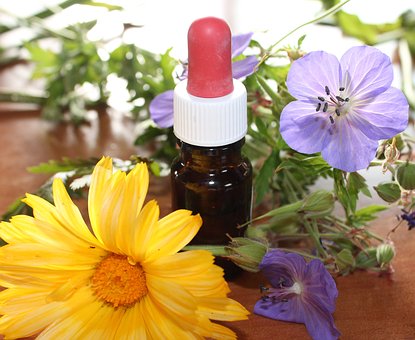Glechoma hederacea
Ground ivy – a herbaceous perennial plant that grows 8 in to 20 in (20 cm to 50 cm) in height on a square stem bearing round, dentate leaves. The flowers are a purplish-blue, tending towards light mauve, for flowering can last 3 months or more, which is exceptional for a wildflower. The leaves give off the smell of camphor with a touch of citronella and peppermint.
At one time ground ivy was highly favored. But today homeowners regard this violet-blue-flowered plant as a weed because it takes over lawns. Herbalists virtually ignore ground ivy, mainly prescribing it as a tea for persistent coughs.
In the first century A.D. the Greek physician Dioscorides taught that a leaf tea was a remedy for sciatica; so, later, did the 16th-century English herbalist John Gerard, citing Dioscorides as his source. Gerard also mentioned that, boiled in a mutton broth, ground ivy was good for weak backs. But he reserved his highest praise for the plant’s effectiveness in treating eye ailments, declaring that, mixed with celandine, daisies, sugar, and rose water, it removed “any grief whatsoever in the eyes. ..it is proved to be the best medicine in the world.”
Ground ivy found its way to America and became a part of the pharmacopoeia of the settlers. Because of its high vitamin C content, herbalists and doctors found ground ivy helpful in treating scurvy. American physicians in the 19th century had a vast range of uses for the herb. They administered the sap or a tea to treat asthma, coughs, consumption, and ulcers in the lungs, and they recommended ground ivy for intestinal gas and fever as well. Doctors also prescribed the tea to treat painter’s colic, or lead poisoning.
Ground ivy is tonic, diuretic, and a decongestant, and is used to treat many problems involving the mucous membranes of the ear, nose, throat, and digestive system. A well-tolerated herb, ground ivy can be given to children to clear lingering congestion and to treat chronic conditions such as “glue ear” and sinusitis. Throat and chest problems, especially those due to excess mucus, also benefit from this remedy. Ground ivy is also a valuable treatment for gastritis and acid indigestion. Further along the gastrointestinal tract, its binding nature helps to counter diarrhea and to dry up watery and mucoid secretions. Ground ivy has been employed to prevent scurvy and as a spring tonic, and is
considered beneficial in kidney disorders.
Ground ivy is native to Europe and western Asia; ground ivy is now naturalized in other temperate regions, including North America. Ground ivy thrives on the outskirts of woods and along paths and hedges. Ground ivy is gathered in summer.
CONSTITUENTS
Ground ivy contains wax, acid, choline, glucides, lipids, protein (glechomine), essential oil, lactone, bitter principle (marrubin), saponins, resin, tannins, vitamin C.
HOW MUCH TO TAKE
Infusion: pour a cup of boiling water onto 1 teaspoonful of the dried leaves and let infuse for 10-15 minutes. This should be drunk three times a day.
Tincture: take 1-4ml of the tincture three times a day.
APPLICATIONS
The flowers can be eaten or used as a lovely garnish for salads. The whole plant can be used in preparing a mother tincture (50% saturated in 100% alcohol; take 15 drops, 3 times daily). It is also easy to dry, requiring less than 1 week. In a decoction and a hot herbal tea, ground ivy is especially good for treating nasal, throat and ear infections by
disinfecting the mucous membranes and liquefying the mucus right down to the lungs.
The ground ivy helps cleanse the lungs through expectoration. Ground ivy also fortifies the bronchial tubes and energizes all the gastrointestinal organs, the urinary system, and the genitals.
Ground ivy is also one of the great healing herbs: compresses made from a concentrated decoction are used to treat abscesses, wounds, cuts and bruises. An herbal tea cure (3 plants in 1 cup [250 ml] water) cleanses the blood and tissues of any toxic heavy metals such as cadmium, copper, lead and zinc: approx. 30 oz (1liter) per day for 10 days or up to 3 months, depending on the seriousness of the poisoning. The dried plant, reduced to a powder, is a sternutator, ideal for headaches and sinusitis.
COLLECTION AND HARVESTING
The flowering stems should be collected between April and June.
COMBINATIONS
For coughs ground ivy may be used with colts-foot, white horehound and elecampane. For sinus catarrh combine ground ivy with golden rod.
HEALING OIL
• 1 3/4 oz (50 g) ground ivy, freshly dried
• 4 cups (1 liter) olive oil
Grind the ivy in a mortar or in a blender. Add the oil and mix. Macerate 1 month and carefully strain. Pour the oil into several small bottles (easier to use and less likely to go rancid).
Excellent for wounds, bruises and even muscular pain.

